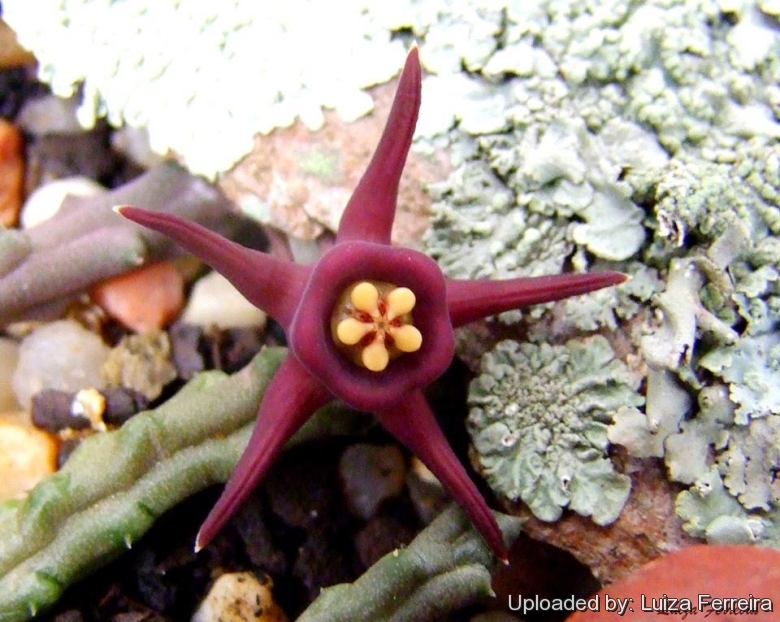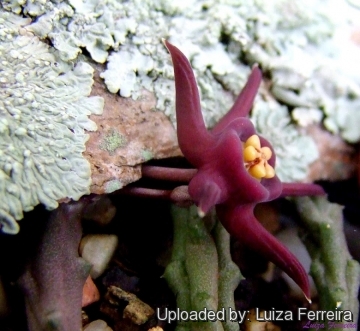
Duvalia immaculata Photo by: Luiza Ferreira
Origin and Habitat: Western Cape (coastal areas from Cape Infanta to Klein Brak River near Mossel Bay.), South Africa. Extent of occurrence less than 1400 km², three to five known locations.
Habitat and Ecology: It grows in arid to relatively moist coastal fynbos vegetation, on shale and limestone. It is threatened by coastal development, wheat farming and stone quarrying. Alien species are also a severe and ongoing threat at all localities.
Synonyms:
Description: Duvalia immaculata is a densely tufted perennial-succulent with cylindrical rhizomatous green stems. It is easily recognisable for it five-pointed, flowers of elaborate design and beauty, distinguished for the enlarged annulus similar to that of Duvalia maculata, with rounded, undulating rim, completely dwarfing the sunken corona, uniformly chocolate, without markings. Corolla 20-30 mm across, dark chocolate, dull, lobes folded lengthwise (replicate) and, apparently, without cilia.
Stems: 2-5 (or under cultivation up to 12) cm long, 6-12 cm thick, oblong-ovoid to cylindrical, rhizomatous, green.
Leaves: Rudimentary less than 1 mm long, obtuse. Stipular rudiments minute, only visible under a lens.
Inflorescences (dichasia): Several in the lower half of the stems.
Flowers: Successively developed mostly erect or procumbent, with slight foetid odour. Ped 5-25 mm long. Sepals approximately 2 mm long. Corolla 2 - 3 cm in diameter, with dull surface, dark chocolate-brown. Corolla-lobes 8-12 mm long, 6-8 mm broad at bas, lamina entirely folded lengthwise. Annulus pentagonal, 8-11 mm across, 0, 2 -3 mm high, bowl-shaped, raised considerably above the disc, rim undulate, completely dwarfing the sunken corona. Corona straw-yellow, disc circular, 3.2-5 mm in diameter. Corona-lobes compact, 1-1.8 mm long, 2 mm thick, outer appendages ovoid, inner ones bluntly fusiform. Pollinia 0.45 x 0.2 mm.
Fruits (paired follicles): 8-15 cm long, fusiform.
Seed: c. 6 x 3.5 mm.
Bibliography: Major references and further lectures:
1) Bruyns, P.V. “Stapeliads of southern Africa and Madagascar.” (Vol. 1, pp. 1-330). Umdaus Press, Pretoria.2005
2) Goldblatt, P. and Manning, J.C. 2000. Cape Plants: “A conspectus of the Cape Flora of South Africa.” Strelitzia 9. National Botanical Institute, Cape Town.
3) Helme, N.A. & Raimondo, D. 2007. Duvalia immaculata (C.A.Lückh.) Bayer ex L.C.Leach. National Assessment: Red List of South African Plants version 2014.1. Accessed on 2015/02/08
4) Doreen Court “Succulent Flora of Southern Africa” CRC Press, 01 June 2000
5) Hermann Jacobsen “Abromeitiella to Euphorbia” Blandford Press, 1960
6) Focke Albers, Ulrich Meve “Illustrated Handbook of Succulent Plants: Asclepiadaceae: Asclepiadaceae” Volume 4 Springer, 2002
 Duvalia immaculata Photo by: Luiza Ferreira
Duvalia immaculata Photo by: Luiza FerreiraSend a photo of this plant.The gallery now contains thousands of pictures, however it is possible to do even more. We are, of course, seeking photos of species not yet shown in the gallery but not only that, we are also looking for better pictures than those already present.
Read More... Cultivation and Propagation: Duvalia immaculataSN|30445]]SN|30445]] is a tiny, but easy obliging blooming plant when mature, that it is happy in any average succulent house. This species favours more humid conditions than other duvalias.
Potting: Since roots are quite shallow, use a soft and incoherent cactus mix or add extra perlite or pumice to regular soil potting soil, and clay pots help the plants to dry out between watering.
Waterings: Duvalia require moderately watering through the growing season but enjoy plenty of water and some fertiliser in hot weather, this helps them to flower freely. Water more sparingly in winter according to temperatures. But, as with most asclepiads, it is unwise to leave them wet in cold weather.
Fertilization: Fertilizers for succulent plants must be rich in potassium, but poor in nitrogen, to avoid the plants from developing excess vegetation, which is easily attacked by fungal diseases.
Sun Exposure: As with many succulents, they prefer to grow in the light shade of scrubby shrubs or between rocks where they get some shade during the day. In summer it is advisable to position this plant in a partially shady place, where it is exposed to direct sunlight only during the coolest hours of the day.
Hardiness: These plants don't like cold weather, therefore in the Spring it is best to set them outside only when the temperatures are above 15°C. Can endure temperatures below 5°C for short period, but only if the soil stays completely dry.
Pest and diseases: Duvalias species vary in their susceptibility to rotting, but are generally fairly easy to grow, especially if kept pest-free. They are very susceptible to stem and root mealy bugs, and damage from these may well initiate fungal attack. If you do have problems with a stem or with basal rotting, you can reliably isolate the healthy parts, dry them off, and re-root them in moist compost.
Cultural Practices: Re-pot every 2 years.
Propagation: Easiest with stem cuttings. Allow cuttings to dry a day before planting. Stems must be laid (Not buried) on gritty compost and will then root from the underside of the stems. It can also be increased from seeds sowing in spring in moist, sandy peat moss. Barely cover seeds. Seeds germinate quickly.











